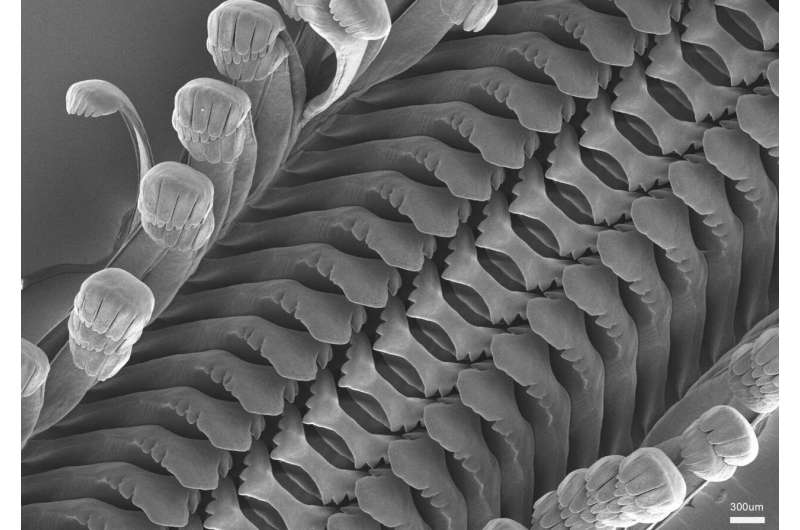Researchers discover how snails chew, and what purpose each part of the 'mouth tool' serves

Their special mouthparts help snails adapt to a wide variety of food and habitats. A research team from the Zoological Institute of Kiel University (CAU) and the Center of Natural History (CeNak) of the University of Hamburg has now been able to biomechanically measure the mechanical performance of the teeth for the first time and derive different functional relations from this. The results have been published in the journal Proceedings of the Royal Society B: Biological Sciences.
There are more than 80,000 snail species worldwide, both on land and in water. They have adapted to their respective habitats and food sources, among other things, by the respective adaptation of their teeth array, so-called radula. This mouth tool consists of a chitinous band covered with dozens to thousands of tiny teeth in longitudinal and transverse rows. Like almost all molluscs, snails use this rasping tongue to grind and process their food. Their teeth are softer than the substrate from which they remove their food. "Nevertheless, we found out in a previous experiment that individual tooth tips can act on the food and its substrate with a pressure of up to 4700 bar. This very high, punctual pressure causes the teeth to wear out quickly. That is why the animals form several new rows of teeth per day," explains Dr. Wencke Krings, Research Associate at CeNak in Hamburg. Krings already investigated the functioning of the teeth in her dissertation at the Universities of Hamburg and Kiel.
Experiments demonstrate different tooth functions
Together with Professor Stanislav N. Gorb and Dr. Alexander Kovalev from the Functional Morphology and Biomechanics working group at the Zoological Institute of Kiel University, she was now able to measure the performance of the teeth in a biomechanical experiment for the first time and describe different functions for different teeth of the radula. To do this, the tooth cusps were loaded to failure with a needle tip attached to a force sensor. The forces that caused the teeth to break or the radula to fail were recorded. "With the help of scanning electron microscope analyses, we measured the areas of fracture to calculate the physical stress that the structures can withstand," says Gorb. For this purpose, snail teeth from existing scientific collections were used.
It showed that some types of teeth can withstand significantly more stress than others. This suggests that different regions of the radula have different functions, the research team said. Some teeth served to scrape food from a surface, others to collect the food. This result is also supported by complementary studies of the material properties of the teeth: "The teeth of species from some habitats are significantly harder than those from others, which shows how strongly the mechanical properties of the radula correlate with the properties of the substrate and food," says Krings.
In some snails, these regional differences are due to iron deposits. In the species studied here, however, and in most snails in general, no iron was found. The structures consist of a chitin-protein composite, so there must be other causes for the presence of mechanical gradients. The density and the arrangement of chitin fibers, but also the degree of tanning of the teeth, which stabilizes the molecular network of the material, should be further investigated in the future.
Surprising results from biomechanics: Teeth stabilize each other
The researchers faced particular challenges in the experiments: Since some snail teeth are only 0.05 to 0.10 millimeters in size, determining the material properties is methodologically complex, even with modern technology. "But our working group is specialized in the characterisation of the smallest biological structures, so the teeth studied here are even quite large in comparison," explains Kovalev. In many international studies, only radula structures in the dry state have been investigated so far, due to the methodological challenge involved, although the snail always keeps its tongue moist when eating.
Therefore the team from Hamburg and Kiel has now developed an experimental set-up to study the teeth in dry and wet condition for the first time—with an unexpected result. Water changes the mechanical properties of biological materials very strongly: Wet materials are significantly softer than dry ones and are normally easier to fail. However, more force was needed to break the wet snail teeth. "When wet, the radula teeth are flexible and their anchorage in the radula ligament is flexible. Thus, the teeth lean on each other and stabilize the whole structure," Gorb explains. "Such experiments are not blindly surveying nature, but provide the basis to understand organisms' diverse adaptations to their environment."
Based on this study, which for the first time successfully used biomechanical methods to investigate mechanical function of the radula and thus feeding adaptations in snails, further experimental approaches are possible to get to the bottom of the snail evolution. In addition, these biomechanical findings could advance the development of special gripping devices in robotics.
More information: Wencke Krings et al. Influence of water content on mechanical behavior of gastropod taenioglossan radulae, Proceedings of the Royal Society B: Biological Sciences (2021). DOI: 10.1098/rspb.2020.3173
Journal information: Proceedings of the Royal Society B
Provided by Kiel University





















